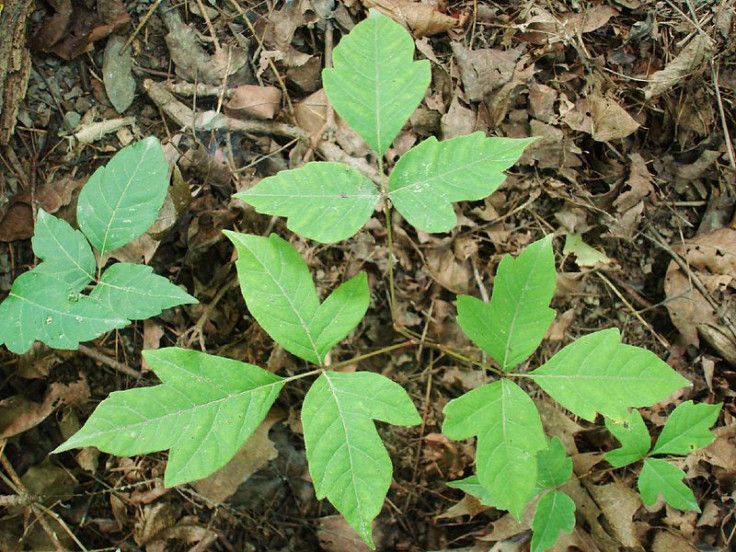Poisonous Plants: How To Identify And Treat Poison Ivy And Other Plants This Summer

It's an itch, it's a rash, it's a blister, it's urushiol-induced contact dermatitis — a common reaction when you come into contact with poison ivy, poison oak, and poison sumac. In the United States, approximately 85 percent of the population is allergic to these poisonous plants, which accounts for an estimated 50 million cases of urushiol-induced dermatitis, says the American Academy of Dermatology (AAD). These summer skin irritants can be potentially dangerous during the season because the sunny, hot weather invites people to spend more time outdoors, which can increase the risk of exposure to the plants. Hawaii, Alaska, and Nevada are the only U.S. states where the poisonous plants do not grow. Reported cases of poison oak are heavily seen in the rural western and southern U.S., while poison ivy cases are more frequent in the eastern U.S., and cases of dermatitis from poison sumac happen less often than from the other two plants, says the University of Illinois Springfield.
Poison ivy, poison oak, and poison sumac are biological hazards, especially for outdoor workers, such as forestry workers and firefighters. The plants are dangerous and can be extremely detrimental to a person's health when they are burned and the toxins are inhaled. Approximately one-third of these workers who fight forest fires in the states of California, Oregon, and Washington develop dermatitis or lung irritations from coming into contact with poison oak, says the Centers For Disease Control And Prevention (CDC).
While plants can often be beautiful decorative pieces to any room or space, they can be potentially dangerous. Plants are one of the top 10 common causes of poisoning in children who are six years old and under. The University of Michigan Health System suggests for those who want to keep plants in the house or landscape their yard, use non-toxic plants to reduce the risk of dermatitis in your child. Even consumption of non-toxic plants can cause severe health problems, especially if consumed in moderate amounts.
This summer, take preventative measures for you and your family and learn how to identify and treat poison ivy and other poisonous plants to protect your health in the outdoors.
How To Identify The Three Poisonous Plants
Poison Ivy
This poisonous plant is more commonly found along the eastern coast of the U.S. as it can either grow as a vine or a shrub. Poison ivy is solid green and has pointed leaves that hang from the stem with three leaflets, says the U.S. Food and Drug Administration (FDA). The look of this plant changes with the seasons. In the spring, the plant has yellow-green leafs whereas in the fall the leaves change to yellow and red. The FDA says poison ivy can also be found to have white berries.
Poison Oak
This summer skin irritant grows in sets of three like poison ivy with solid green leaves that resemble those of an oak tree. Poison oak grows as a shrub in the eastern part of the U.S. and in tall clumps or long vines on the Pacific Coast, says the FDA. The poisonous plant may contain yellow-white berries.
Tip: Remember poison ivy and poison oak come in leaves of three.
Poison Sumac
Unlike poison ivy and poison oak, this plant can be commonly found in bogs or swamps where it grows as a small tree or a tall shrub. The plant contains urushiol-filled black or brownish-black spots where each leaf stem has seven to 13 leaflets, says the FDA. Poison sumac like poison oak may have yellow-white berries.
Severity of Rash
A rash from a poisonous plant often looks like a straight line if the plant came into direct contact with your skin. However, if you come into contact with an item that has urushiol from a plant, the rash be spread throughout the body. The severity of the rash is contingent on the amount of urushiol that is originally on your skin. The more urushiol the exposed area has, the sooner it will develop a rash, says Mayo Clinic.
Tip: Avoid touching other parts of the body if the plant's oil is on your fingers.
Symptoms
A rash from a poisonous plant can take anywhere from 12 to 48 hours to develop and lasts approximately two to three weeks. If you are unsure whether you have dermatitis from a poisonous plant, the AAD recommends to look for the following symptoms:
Moderate Poison Ivy, Poison Oak and Poison Sumac Rash
- The rash appears on a small section of your skin.
- You are absolutely certain that your rash is due to poison ivy, poison oak, or poison sumac. If you are not certain, see a dermatologist and do not try to treat the rash at home.
Severe Poison Ivy, Poison Oak and Poison Sumac Rash - Go To The Emergency Room
- Trouble breathing or swallowing.
- Rash covers most of your body.
- You have many rashes or blisters.
- Swelling, especially if an eyelid swells shut.
- Rash develops anywhere on your face or genitals.
- Much of your skin itches or nothing seems to ease the itch.
How To Treat A Poison Ivy, Poison Oak and Poison Sumac Rash
If you have a mild case of a poisonous plant rash, medical treatment is not required. The Poison Ivy, Oak, & Sumac Information Center says if you know you came in contact with a poisonous plant, it is wise to wash the skin multiple times with soap and water. Avoid touching all but the exposed area of the rash because the spread of the oil can cause irritation. The use of calamine lotion, Epsom salts, or bicarbonate of soda can help treat blisters and red, itching skin.
Published by Medicaldaily.com



























